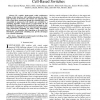Free Online Productivity Tools
i2Speak
i2Symbol
i2OCR
iTex2Img
iWeb2Print
iWeb2Shot
i2Type
iPdf2Split
iPdf2Merge
i2Bopomofo
i2Arabic
i2Style
i2Image
i2PDF
iLatex2Rtf
Sci2ools
TON
2002
2002
Packet-mode scheduling in input-queued cell-based switches
We consider input-queued switch architectures dealing at their interfaces with variable-size packets, but internally operating on fixed-size cells. Packets are segmented into cells at input ports, transferred through the switching fabric, and reassembled at output ports. Cell transfers are controlled by a scheduling algorithm, which operates in packet-mode: all cells belonging to the same packet are transferred from inputs to outputs without interruption. We prove that input-queued switches using packet-mode scheduling can achieve 100% throughput, and we show by simulation that, depending on the packet size distribution, packet-mode scheduling may provide advantages over cell-mode scheduling.
| Added | 23 Dec 2010 |
| Updated | 23 Dec 2010 |
| Type | Journal |
| Year | 2002 |
| Where | TON |
| Authors | Marco Ajmone Marsan, Andrea Bianco, Paolo Giaccone, Emilio Leonardi, Fabio Neri |
Comments (0)

